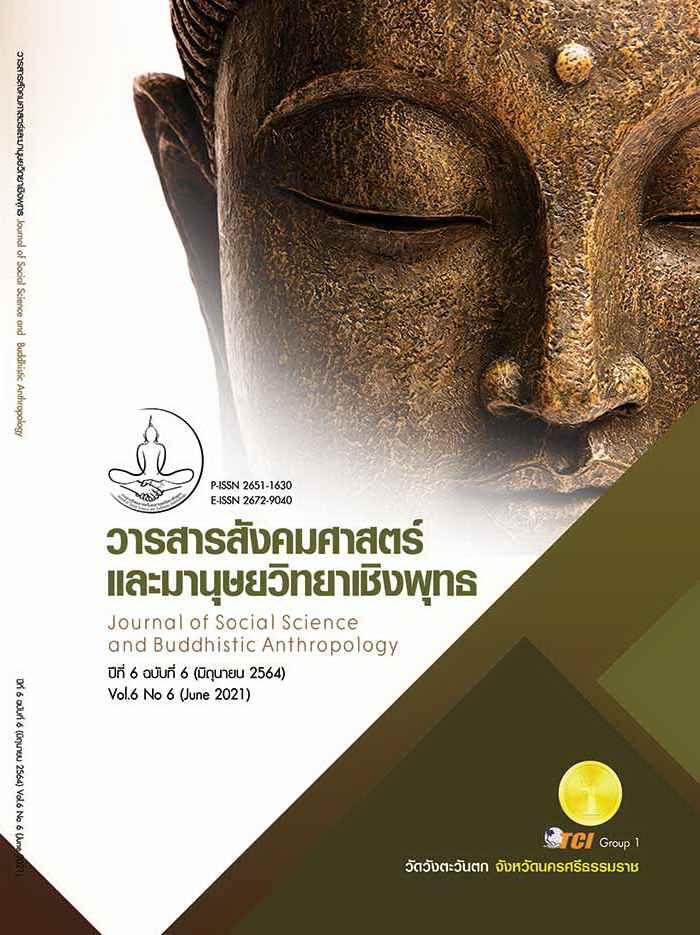DEVELOPMENT OF INTEGRATION IN A DANCE INSTRUCTION FOR UNDERGRADUATE STUDENTS IN GENERAL EDUCATION AT RAJAMANGALA UNIVERSITY OF TECHNOLOGY
Keywords:
Development, Dance Instruction Model, Integration, General EducationAbstract
The objective of this research was to develop a dance integration instruction model for undergraduate students in General Education at Rajamangala University of Technology. This study was a synthesis and an evaluation research with Delphi technique which involved 4 target groups; 19 experts in quality assessment, 7 experts in checking tools quality, 3 dance instructors in objectivity and 30 undergraduate students from Rajamangala University of Technology in dance skill assessment. The data was subsequently analyzed using median, interquartile range, validity, objectivity, discrimination and reliability criteria. The results showed the development and effectiveness of the dance integration instruction model in the six components were terms of; 1) principles 2) purposes 3) contents 4) instruction models 5) media and tools and 6) measurements and evaluations. Based on the findings and 16 lesson plan management, it was concluded that the study was accurate, appropriate, useful and applicable. The results of the assessment were as follows; The median was 4.00 - 5.00 which was above the level of 3.50 and the interquartile range was 0.00 - 1.00 which was not over 1.50. Therefore, the assessment met all criteria. In addition, the dance skill assessment forms reveled the validity level at 0.86 - 1.00, objectivity level at 0.83 -1.00, discrimination level at 0.31 - 0.42, reliability at 0.83 and satisfaction rate at 0.71 - 1.00 which satisfy all criteria.
References
กุลิสรา จิตรชญาวณิช. (2562). การจัดการเรียนรู้. กรุงเทพมหานคร: สำนักพิมพ์จุฬาลงกรณ์มหาวิทยาลัย.
คณะกรรมการการศึกษาขั้นพื้นฐาน สำนักบริหารงานการมัธยมศึกษาตอนปลาย. (2560). แนวทางการจัดทักษะการเรียนรู้ในศตวรรษที่ 21 ที่เน้นสมรรถนะทางสาขาวิชาชีพ. เรียกใช้เมื่อ 19 สิงหาคม 2562 จาก https://secondary.obec.go.th/newweb/ wp-content/uploads/2017/12/E-EN21book.pdf
คณะกรรมการเอกลักษณ์ของชาติ สำนักนายกรัฐมนตรี. (2542). พระบรมราโชวาท. เรียกใช้เมื่อ 28 กรกฎาคม 2562 จาก http://www.identity.opm.go.th/identity /content/index.asp
จินตนา สรายุทธพิทักษ์. (2558). โปรแกรมสุขภาพในโรงเรียน. (พิมพ์ครั้งที่ 2). กรุงเทพมหานคร : โรงพิมพ์แห่งจุฬาลงกรณ์มหาวิทยาลัย.
ณิรดา เวชญาลักษณ์. (2561). หลักการจัดการเรียนรู้. กรุงเทพมหานคร: สำนักพิมพ์จุฬาลงกรณ์มหาวิทยาลัย.
ทิศนา แขมมณี. (2561). ศาสตร์การสอน. กรุงเทพมหานคร: จุฬาลงกรณ์มหาวิทยาลัย.
ธงชัย สมบูรณ์. (2562). วาทกรรมการศึกษาไทย. กรุงเทพมหานคร: สำนักพิมพ์จุฬาลงกรณ์มหาวิทยาลัย.
บุญชม ศรีสะอาด. (2553). การวิจัยเบื้องต้น. กรุงเทพมหานคร: สำนักพิมพ์สุวีริยสาสน์.
บุญเลิศ กระบวนแสง. (2561). โยกย้ายสะโพกกับ"ลีลาศ" วัคซีนต้านโรค-ฝึกการทรงตัว. เรียกใช้เมื่อ 22 ตุลาคม 2563 จาก ttps://www.thaipost.net/main/detail/17332
พวงรัตน์ ทวีรัตน์. (2543). วิธีการวิจัยทางพฤติกรรมศาสตร์และสังคมศาสตร์. (พิมพ์ครั้งที่ 8). กรุงเทพมหานคร: สำนักทดสอบทางการศึกษาและจิตวิทยา มหาวิทยาลัยศรีนครินท-รวิโรฒ.
พิชิต ภูติจันทร์. (2549). กีฬาลีลาศ. กรุงเทพมหานคร: โอเดียนสโตร์.
รังสฤษฏิ์ บุญชลอ. (2551). (2551). ประวัติและการลีลาศ Social Dance. (พิมพ์ครั้งที่ 4). กรุงเทพมหานคร: สกายบุกส์จำกัด.
วรศักดิ์ เพียรชอบ. (2561). รวมบทความเกี่ยวกับปรัชญา หลักการ วิธีสอนและการวัดเพื่อประเมินผลทางพลศึกษา. กรุงเทพมหานคร: จุฬาลงกรณ์มหาวิทยาลัย.
วัชรา เล่าเรียนดี และคณะ. (2560). กลยุทธ์การจัดการเรียนรู้เชิงรุกเพื่อพัฒนาการคิดและยกระดับคุณภาพการศึกษาสำหรับศตวรรษที่ 21. (พิมพ์ครั้งที่ 12). กรุงเทพมหานคร: สำนักพิมพ์เพชรเกษมพริ้นติ้ง กรุ๊ป จำกัด.
สังวร จันทรกร. (2561). ลีลาศเพื่อสุขภาพ. กรุงเทพมหานคร: โรงพิมพ์อินดี้ พริ้นตริ้ง.
สุวิมล ว่องวานิช. (2549). การประเมินอภิมาน. กรุงเทพมหานคร: จุฬาลงกรณ์มหาวิทยาลัย.
Bloom, B. J. et al. (1956). Taxonomy of Educational Objectives Handbook I Cognitive Domain. New York: David McKay.
Lasley, T. J. & Matczynski, T. J. . (1997). Strategies for teaching in a diverse society: Instructional models. Belmint. CA: Wadsworth.
Likert, R. A. . (1961). New Patterns of Management. New York: McGraw-Hill Book Company Inc.
Maslow, A. H. (1943). A Theory of Human Motivation. Journal Psychology Review, 50(1), 370 - 396.
Rovinelli, R. J. & Hambleton, R. K. (1997). On the use of content specialists in the assessment of criterion-referenced test item validity. Dutch Journal of Educational Research, 2(1), 49 - 60.
Tripp, S. D. & Biche meyer, B. (1990). Rapid - Prototyping: An Alternative Instructional Design-Strategy. Educational Technology Research and Development, 38(1), 31-44.
Wright, J. P. (2013). Social Dance : Steps to Success. Illinois : Human Kinetics, Inc.








